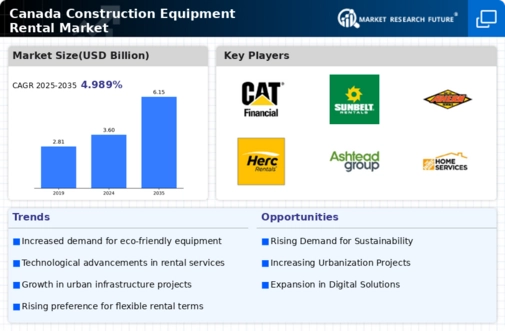Rising Construction Activities
The construction equipment-rental market in Canada is experiencing a notable surge due to increasing construction activities across various sectors. The demand for residential, commercial, and infrastructure projects is driving the need for rental equipment. In 2025, the construction sector is projected to grow by approximately 4.5%, leading to a heightened requirement for machinery such as excavators, loaders, and cranes. This growth is further fueled by government investments in infrastructure, which are expected to reach $10 billion in the next fiscal year. Consequently, rental companies are likely to benefit from this trend, as contractors prefer renting over purchasing equipment to manage costs effectively. The rising construction activities thus serve as a significant driver for the construction equipment-rental market, indicating a robust outlook for rental services in the coming years.
Shift Towards Flexible Financing
The construction equipment-rental market is witnessing a shift towards flexible financing options, which is becoming increasingly attractive for contractors and construction firms. With the rising costs of equipment ownership, many companies are opting for rental solutions that provide financial flexibility. In 2025, it is estimated that around 60% of construction firms in Canada will prefer renting equipment to mitigate upfront costs. This trend is particularly pronounced among small to medium-sized enterprises that may lack the capital for large purchases. Rental agreements often include maintenance and support, further enhancing their appeal. As a result, the construction equipment-rental market is likely to expand, driven by the demand for cost-effective and flexible financing solutions that align with the dynamic needs of the construction industry.
Increased Urban Development Projects
the market is benefiting from a surge in urban development projects across Canada. As cities expand and evolve, there is a growing need for infrastructure improvements, including roads, bridges, and public transportation systems. In 2025, urban development initiatives are expected to account for a significant portion of construction spending, estimated at $15 billion. This trend is prompting construction firms to seek rental solutions for specialized equipment required for urban projects, such as compactors and aerial lifts. The flexibility and cost-effectiveness of renting equipment are appealing to contractors engaged in these large-scale urban projects. Therefore, the increased focus on urban development is a crucial driver for the construction equipment-rental market, suggesting a positive trajectory for rental services in the foreseeable future.
Technological Advancements in Equipment
Technological advancements are playing a pivotal role in shaping the construction equipment-rental market. The integration of smart technologies, such as telematics and automation, is enhancing the efficiency and safety of rental equipment. In 2025, it is projected that approximately 30% of rental equipment will be equipped with advanced technology features, allowing for real-time monitoring and predictive maintenance. This not only improves operational efficiency but also reduces downtime, making rental options more appealing to contractors. As construction projects become more complex, the demand for technologically advanced equipment is likely to increase, thereby driving growth in the construction equipment-rental market. The ability to offer state-of-the-art machinery will be a key differentiator for rental companies in a competitive landscape.
Environmental Regulations and Compliance
The construction equipment-rental market is increasingly influenced by stringent environmental regulations and compliance requirements. In Canada, the government is implementing policies aimed at reducing carbon emissions and promoting sustainable practices within the construction sector. As a result, rental companies are adapting their fleets to include more eco-friendly equipment, such as electric and hybrid machinery. By 2025, it is anticipated that the share of environmentally compliant equipment in rental fleets will rise to 25%. This shift not only helps construction firms meet regulatory standards but also appeals to environmentally conscious clients. Consequently, the construction equipment-rental market is likely to see growth as companies seek to align with sustainability goals while maintaining compliance with evolving regulations.



















Leave a Comment